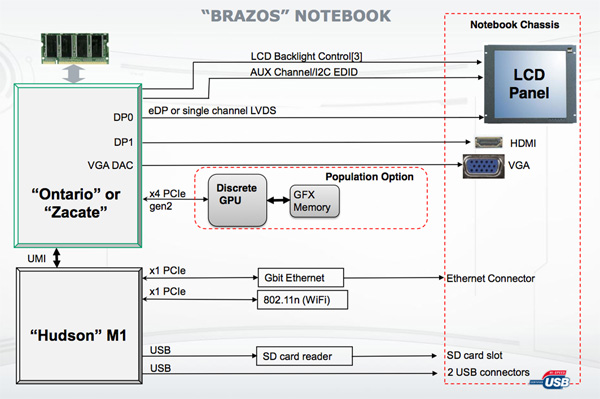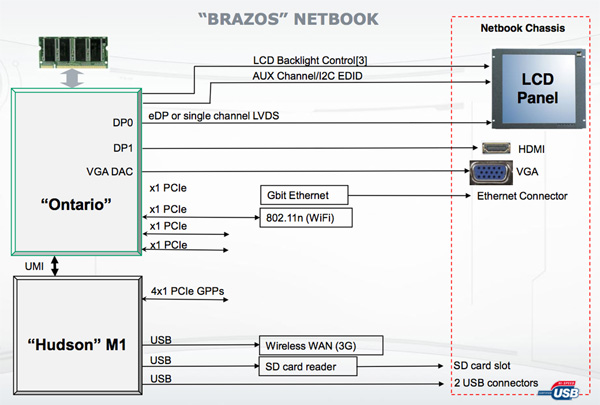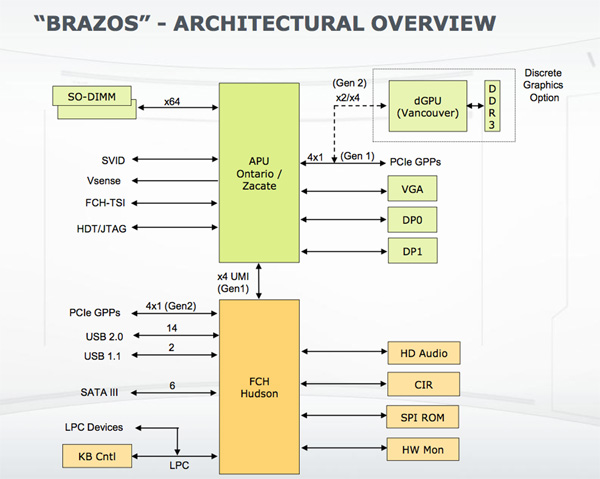Previewing AMD's Brazos, Part 1: More Details on Zacate/Ontario and Fusion
by Anand Lal Shimpi on November 9, 2010 1:09 AM ESTThe Chipset err...Fusion Controller Hub
The Zacate/Ontario APUs have an integrated PCIe interface sporting 8 lanes. Four of those lanes are used for AMD’s Universal Media Interface (UMI) - a bus that links the APU to the Hudson FCH. The remaining four can be used for discrete graphics or a combination of discrete graphics and other PCIe controllers. Both PCIe interfaces can run at gen 1 or gen 2 transfer rates.
Display output naturally stems off of the APU. You can drive two displays in tandem over any combination of VGA or Display Port/DVI/HDMI/LVDS.
As I mentioned earlier, the APU sports a single channel memory controller - but you can install up to two DIMMs on that channel. Speeds are down from the 1333MHz system we tested at IDF, DDR3-1066 is the max you’ll officially see on a Brazos system.
The Hudson FCH supplies up to 14 USB 2.0 ports, 6 x 6Gbps SATA ports and another 4 PCIe lanes. The FCH is based on AMD’s SB800 series of South Bridges. Despite the small size, this is a full featured platform.
From the looks of it, AMD has all of the right ingredients for some very competitive entries in the mainstream and ultraportable notebook markets. Now it’s just up to the OEMs to build something cool out of it.
Check back in about a week for the full rundown on Zacate performance.













106 Comments
View All Comments
iwodo - Tuesday, November 9, 2010 - link
Relatively powerful GPU sounds not very good. If i consider 1 being first gen, 6 would be 6th gen already. Even though some of these are half gen, I would be very sad if a 5 years later Low end GPU cant outplaform my Mid Range from Gfx computer..Shadowmaster625 - Tuesday, November 9, 2010 - link
X1600M looks like a slightly faster nvidia ION. Zacate is definately faster than that. According to the numbers from the preview from 6 weeks ago, it will be about 30% faster.The question is, how close will Ontario be to beating the performance of your X1600M laptop? I bet they will be so close you wont be able to tell the difference.
plonk420 - Tuesday, November 9, 2010 - link
i can't wait to put this in my HTPC!i just hope it can keep up with AnyDVD HD and realtime BD+ decryption...
Setsunayaki - Tuesday, November 9, 2010 - link
True freedom isn't about the actual processor. Its about the performance.If you run windows even under a low performance setting, the system is hurt by the fact one needs to run antiviruses, firewalls, spyware and adware removal tools. It means running Windows with a pair of bobcats + the GPUs are going to have their power spent on keeping those "Security" programs up.
AMD itself can not code a decent Linux Driver to the point performance is going to be shot to hell on Linux.
I'd much rather have a laptop with an nvidia solution running a linux system as it means I get performance since decent nvidia drivers exist on linux, and one doesn't have to run any of the security programs one has to run on Linux and the performance efficiency is a lot higher on Linux.
All what fusion is going to do is increase the level of dependency people have to windows.
jabber - Tuesday, November 9, 2010 - link
All you need is MS Security Essentials and maybe Malwarebytes sitting there dormant as a backup.Dont need anything more.
Shouldnt make any PC sweat.
blowfish - Tuesday, November 9, 2010 - link
That's got to be a joke! Have you ever noticed how MSSE can put a system into a pregnant pause every now and then? Watch the service in Task Manager, for example. On a low powered system, those pauses could be very long, and quite disruptive.MFK - Tuesday, November 9, 2010 - link
I have what I would consider a low powered PC.An AMD 3200+ Athlon 64 Single Core.
1 GB of ram and a Nvidia 7200SE.
I have only MSSE and Zone Alarm installed on Windows 7 for almost a year now.
I have yet to have a problem with virus/spam/pop ups.
Point being: I have not noticed these pregnant pauses you speak of.
:S
jabber - Tuesday, November 9, 2010 - link
I havent seen them. Running it on around 8 of my own PCs (singles to quads). I think I would have seen that by now.Maybe you have something wrong with your PC?
Prosthetic Head - Tuesday, November 9, 2010 - link
AMD/ATI Linux support has actually got a whole lot better in the last year or 2.I've got a 4870 (closed catalyst driver) in my desktop which only ever runs Ubuntu, and an x300 (open 'radeon' driver) in my laptop. They are running well w.r.t both speed and stability.
AMD are also providing specs and some dev time to the open drivers so there is now varying levels of 2D and 3D acceleration working well in the open drivers - which is more than you can say for nVidia.
I have also found that AMD vs Intel performance results are different under linux vs windows (much windows software is compiled using intels ICC and with more optimisation effort for intel processors). AMD generally perform relativity better under Linux (GCC compiler).
Marburg U - Tuesday, November 9, 2010 - link
Large versions of this article's images are unavailable.